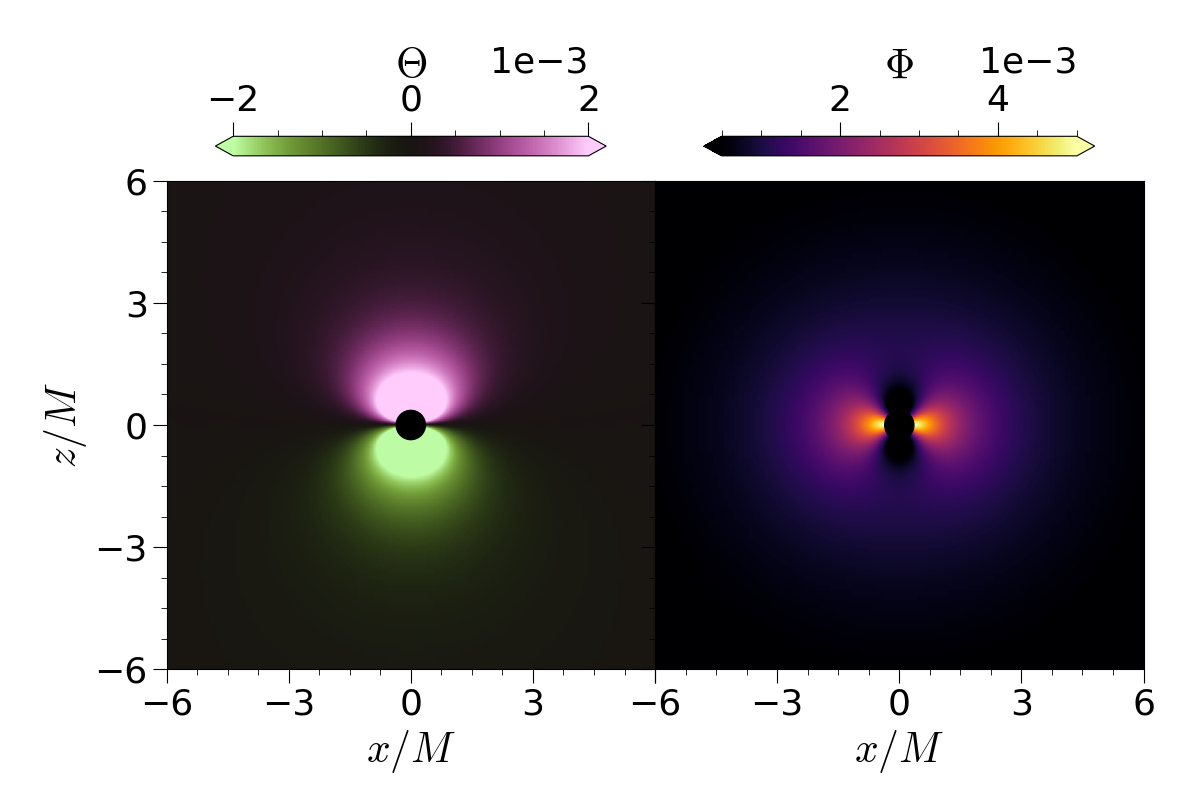Gallery: Black-hole hair in axi-dilaton gravity
This simulation evolves a single black hole in a theory of modified gravity called "axi-dilaton" gravity (Cano & Ruipérez 2022, Kanti & Tamvakis 1995) using the AxiDilaton arrangement as a part of the Canuda code for exploring fundamental physics. This model of gravity includes a pseudo-scalar (or axion) field, \(\Theta\), and a scalar (or dilaton) field, \(\Phi\), which are kinetically coupled to one another. In this simulation, we evolve these fields in the background of a single rotating black hole until they settle to non-trivial profiles around the black hole which we refer to as axion and dilaton hair. The fields are initialized to be the analytical axion and dilaton hair solutions in the low-spin, low-coupling approximation in axi-dilaton gravity (Cano & Ruipérez 20222). For both the axion and dilaton fields, we present the time evolution of the leading order multipoles at a given extraction radius as well as two-dimensional profiles sliced perpendicular to the equatorial plane. The AxiDilaton arrangement and an analysis of the axion and dilaton hair growth in a black hole spacetime are presented in Richards et. al. 2025.
The plots show the leading order scalar multipoles, \(\Theta_{10}\) and \(\Theta_{30}\) as well as \(\Phi_{00}\) and \(\Phi_{20}\), evolving in the background of a black hole with spin \(\chi = 0.9\) extracted at \(r_{ex} = 20M\) and with a coupling strength of \(\hat{a}_{s}=0.01\). These modes give the leading order contributions to the axion and dilaton hairs, respectively. Finally, we include a two-dimensional slice along the axis of rotation in the xz-plane for both the axion and dilaton fields at a late time, once the fields have settled to their final profiles.
Simulation details
Computational details
| Thornlist | axidilaton.th |
|---|---|
| Parameter File | single_bh_axidilaton.par |
| Submission command |
simfactory/bin/sim create-submit aSpt01_apt9 --config sim --parfile repos/Canuda_AxiDilaton/par/single_bh_axidilaton.par --procs 112 --machine frontera --queue small
|
| Total memory | 63 GB |
| Run time | Approximately 7 hours using two nodes (112 cores) on Frontera or ~800 CPU hours |
| Results (gzip 496MB, uncompressed 657MB) | single_bh_axidilaton-20241206.tar.gz |
This example was last tested on 6-Dec-2024.
The evolution of dominant and subdominant modes of the axion (\(\Theta\)) and dilaton (\(\Phi\)) fields around a Kerr black hole of spin \(\chi = 0.9\) extracted at \(r_{ex} = 20M\) and with a coupling strength of \(\hat{a}_{s}=0.01\). These plots can be generated using AxiDilGalleryExample_timeseries.py. See the bottom of the file for an example of how to use the script.
Axion (\(\Theta\)) and dilaton (\(\Phi\)) field profiles in a slice perpendicular to the equatorial plane. This plot can be generated using Kuibit with AxiDilGalleryExample_xz_snapshot.py. See the bottom of the file for an example of how to use the script.
